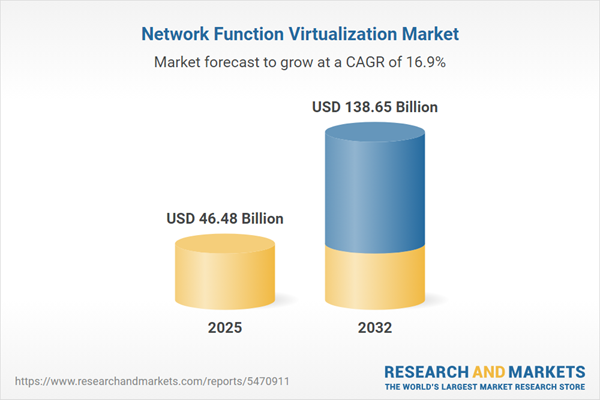Speak directly to the analyst to clarify any post sales queries you may have.
Network function virtualization (NFV) is accelerating enterprise transformation by streamlining network operations and enabling organizations to respond rapidly to shifting business objectives. As enterprises and telecom providers prioritize digital strategies, NFV delivers operational agility and adaptable infrastructure.
Market Snapshot: Network Function Virtualization Market Growth and Outlook
The global network function virtualization market is advancing quickly as organizations migrate from traditional hardware to agile, software-driven architectures. A robust compound annual growth rate highlights widespread industry confidence and growing market readiness. Notable traction is visible across North America, EMEA, and Asia-Pacific, with each region propelled by demands for flexible, high-performing network operations. Innovations in network security and compliance frameworks are further enhancing NFV adoption, allowing organizations to embed NFV into their broader digital transformation plans and connect seamlessly with next-generation digital initiatives.
Scope & Segmentation: Key NFV Adoption Considerations
- Component: Hardware, software, managed services, and professional services each address critical needs in network performance, security, and efficient management. These elements support tailored deployments and help maximize uptime and network reliability.
- Function: NFV empowers functions such as firewalls, IP multimedia subsystems, routing, load balancing, and virtual packet core. By virtualizing these functions, organizations gain flexibility and can align network features directly with digital pathways.
- Deployment Model: Flexible deployment options, including private, public, hybrid cloud, and on-premises, cater to varying scenarios in operational risk, data residency, and compliance management.
- End User: NFV supports a diverse range of adopters—scalable solutions for small businesses, efficiency improvements for large enterprises, resilient service platforms for telecom operators, and secure delivery for public sector agencies.
- Regional Coverage: The Americas, EMEA, and Asia-Pacific each present specific market drivers. Regional regulations, investment climates, and strategic alliances contribute to distinct adoption curves and assist organizations in maximizing NFV value across different contexts.
- Key Players: Industry-leading vendors—including Cisco Systems, Huawei Technologies, Ericsson, Nokia Corporation, Juniper Networks, VMware, Hewlett Packard Enterprise, ZTE Corporation, Ciena Corporation, and Fujitsu Limited—are central to advancing NFV standards and shaping market innovation.
Key Takeaways: Executive Insights for NFV Deployment
- Transitioning to software-defined architectures supports organizations in maintaining responsive, adaptable operations that can align quickly with evolving business strategies and regulatory standards.
- Adopting cloud-native and containerized NFV methodologies streamlines network automation and accelerates rollout timelines, delivering responsive scaling as business priorities emerge.
- Conforming deployment approaches to regional and sector-specific compliance requirements positions organizations for stable growth and flexibility as regulations and technologies evolve.
- Leverage open-source and multi-vendor NFV platforms to encourage ecosystem innovation while minimizing risk of provider lock-in and supporting ongoing technological advancements.
- NFV implementation creates a strong base for advanced services such as 5G and edge computing by providing real-time network resource allocation and supporting innovative digital applications.
- Integrating NFV with software-defined networking increases organization-wide agility and helps maintain momentum across enterprise transformation programs and public sector modernization efforts.
Tariff Impact
Recent changes in United States tariffs have increased costs associated with NFV hardware and software procurement. Technology providers are reconfiguring production workflows and supply chain strategies to guard against disruption, ensuring that organizations retain reliable access to NFV solutions. In response to these pressures, many organizations are exploring open-source NFV platforms to secure greater flexibility in sourcing and to reduce reliance on single suppliers. For global enterprises, these developments highlight the need for dynamic risk management and adaptive strategies when deploying NFV infrastructure in diverse regulatory environments.
Methodology & Data Sources
This report is developed using industry benchmarks, in-depth discussions with senior network architects, telecom leaders, and system integrators, as well as comprehensive case study analyses. Each finding is validated to provide decision-makers with actionable insights for successful NFV planning, selection, and deployment.
Why This Report Matters
- Equips leaders with comprehensive network function virtualization market analysis to refine strategic investment decisions and address operational risks.
- Offers thorough segmentation across components, deployment models, and regions, supporting informed procurement and vendor management.
- Highlights regulatory and supply chain complexities, delivering guidance for uninterrupted NFV implementation and sustained network operations.
Conclusion
Network function virtualization is a pivotal enabler of digital transformation, supporting organizations in aligning infrastructure with growth targets and evolving operational requirements.
Additional Product Information:
- Purchase of this report includes 1 year online access with quarterly updates.
- This report can be updated on request. Please contact our Customer Experience team using the Ask a Question widget on our website.
Table of Contents
3. Executive Summary
4. Market Overview
7. Cumulative Impact of Artificial Intelligence 2025
List of Figures
Companies Mentioned
The companies profiled in this Network Function Virtualization market report include:- Cisco Systems, Inc.
- Huawei Technologies Co., Ltd.
- Telefonaktiebolaget LM Ericsson
- Nokia Corporation
- Juniper Networks, Inc.
- VMware, Inc.
- Hewlett Packard Enterprise Company
- ZTE Corporation
- Ciena Corporation
- Fujitsu Limited
Table Information
| Report Attribute | Details |
|---|---|
| No. of Pages | 198 |
| Published | November 2025 |
| Forecast Period | 2025 - 2032 |
| Estimated Market Value ( USD | $ 46.48 Billion |
| Forecasted Market Value ( USD | $ 138.65 Billion |
| Compound Annual Growth Rate | 16.8% |
| Regions Covered | Global |
| No. of Companies Mentioned | 11 |









